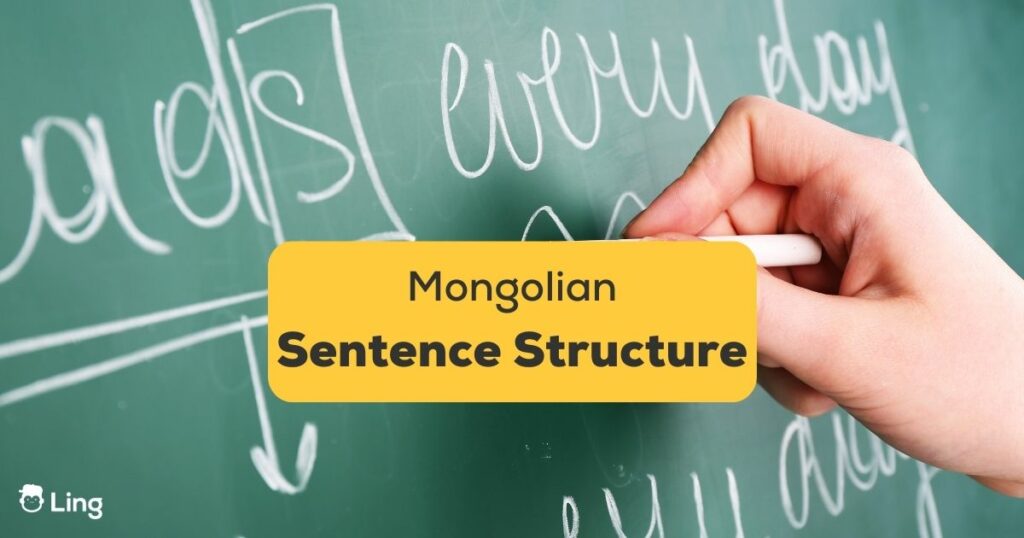Looking for a language that has a unique sentence structure and a rich history? Look no further than the Mongolian language. It’s an intriguing language that draws you in with its distinctive sentence structure and vocabulary, while maintaining vowel harmony. Understanding the basic components of spoken language and how to form a Mongolian sentence is vital for anyone who wants to dive deeper into the language.
Essential Parts Of Mongolian Sentence Structure
Let’s explore the four essential components of Mongolian sentences: the subject, predicate, object, and adverbial.
Subject
The subject is the hero of the sentence and is typically marked by nouns placed at the beginning. It’s the noun or pronoun that performs the action in the sentence. For instance, in the sentence “Намайг бичих гэж байна.” (I want to write), the subject is “Намайг” (I).
Predicate
The predicate, on the other hand, is the supporting actor or passive voice that describes the action or state of being of the subject of the sentence. In Mongolian languages, the predicate is usually placed at the end of the sentence. For example, in the sentence “Би сургуульд залгаараа ажиллаж байна.” (I am working hard at school), the predicate is “ажиллаж байна” (working hard).
Object
The object is the recipient of the verb’s action, and it usually comes after the verb stem predicate in Mongolian sentences. For example, in the sentence “Би бичих гэж байгаа сэдэв нь хамгийн сонирхолтой сэдэв юм.” (The topic that I want to write about is the most interesting one), “сэдэв” (topic) is the object.
Adverbial
Lastly, the adverbial is an optional component that adds flavor to the sentence by providing additional information about the action or state of being of the subject. It can be a word, phrase, or clause that modifies the verb. In Mongolian, the adverbial can be placed either before or after the predicate. For example, in the sentence “Би баярлаж сэтгэлээ сарууллаа.” (I am happily expressing my feelings), “баярлаж” (happily) is adverbial.
Mastering the Mongolian language requires a good understanding of its basic components. By knowing the subject, predicate, object, and adverbial, you can construct and comprehend more intricate sentences. You can appreciate the beauty and complexity of different forms of Mongolian sentence structure by practicing and immersing yourself in the language.
Basic Sentence Structure

Mongolian grammar, with its mesmerizing sentence structure, has been captivating the minds of language enthusiasts around the world for many languages. It’s spoken by over six million people globally and is renowned for its unique syntax. Let’s dive into the captivating world of Mongolian sentence structure and explore the pivotal role of word order in conveying meaning.
SOV Word Order
Mongolian sentence structure generally follows the subject-object-verb (SOV) form of word order, which means that the subject comes first, followed by the object, and finally, the verb. For instance, “The cat catches the mouse” would be “Cat mouse catch.”
For English speakers learning Mongolian, the difference in the SOV word order could be perplexing to comprehend, as English primarily follows a subject-verb-object (SVO) word order.
Exceptions To SOV Word Order
While SOV is the most common form of word order in Mongolian, it does come with exceptions. For example, adverbs often come before the verb. Moreover, in some instances, the object can come before the subject. The word order depends on the context and emphasis in these cases.
Importance Of Word Order
The significance of word order in conveying meaning in Mongolian cannot be overstated. A slight alteration in the order of words can lead to a whole different interpretation. For instance, “Man horse sees” could either mean “The man sees the horse” or “The horse sees the man,” among other examples, depending on the context of Mongolian words and word order.
Furthermore, understanding the correct word order can significantly enhance one person’s ability to speak and comprehend Mongolian, as it is an essential characteristic of Mongolian sentence structure. Although exceptions exist, understanding the importance of word order in conveying meaning is crucial for effective communication.
The Mongolian Cyrillic Alphabet
The Mongolian Cyrillic alphabet is more than just a writing system. It’s an essential component of Mongolian culture and identity, serving as a tool for effective communication in the Mongolian language. With 35 letters, including six with additional variants, the Cyrillic script was introduced in the 1940s and replaced the traditional Mongolian script.
The cyrillic alphabet plays a critical role in conveying meaning. It helps in writing Mongolian words and sentences phonetically, reflecting the unique sounds of the language. Additionally, the script aids in understanding the word order of Mongolian sentence structure, which, as we said, typically follows the SOV structure.
While the Cyrillic script may seem daunting to non-native speakers, it’s crucial to learn and understand its role in the Mongolian language. By doing so, language learners can greatly improve their ability to speak and comprehend the language. The Mongolian Cyrillic alphabet is not just a writing system, but a crucial component of the Mongolian language and culture.
Mongolian Cases
Cases are grammatical categories that help indicate the relationship between different parts of a sentence. Understanding the different cases used in Mongolian sentences is essential for effective communication in the language.
The six cases used in Mongolian sentences are nominative, accusative, dative, genitive, ablative, and instrumental. Each case has a unique function and helps convey meaning in a sentence. The nominative case indicates the subject of a sentence, while the accusative case identifies the direct object. The dative case, on the other hand, shows the indirect object, and the genitive case indicates possession or a relationship between two nouns. The ablative case expresses movement away from an object, and the instrumental case indicates a tool or means.
Why Learn Cases
Cases play a vital role in sentence structure in Mongolian. They help clarify the relationship between different parts of a sentence, such as the subject, object, and indirect object. They also help identify possession and other relationships between nouns. Cases can also be used to clarify the meaning of a sentence, especially when word order is ambiguous.
Mastering the use of cases in Mongolian is essential for effective communication in the language. By understanding the different cases and their functions, language learners can greatly improve their ability to speak and comprehend the language. It takes practice and dedication to master the use of cases, but it’s a worthwhile investment in learning the language. And with these grammar rules, most people turn into apps like Rosetta Stone. But, there’s no Mongolian on Rosetta stone! What’s the next best step?
Wrapping Up

If you want to learn Mongolian, or the national language of any country, then check out Ling. It covers concepts like borrowed words, possessive pronouns, negative form, vowel length, and dictionary forms, among many others, and takes you to the more advanced topics in no time.
Download Ling today from Google Play Store or App Store and start your journey to fluency in Mongolian!
Enjoyed this post? Also, check out our guides for Mongolian phrases and shopping vocabulary.






























































